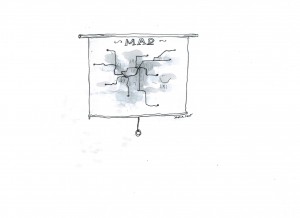
A lot of mapmakers end up selling posters, Yale professor Bill Rankin tells me, but he wants his projects to be something more. He wants to re-imagine the conventions of cartography, going beyond images you could hang for display or decoration. A Rankin map might be aesthetically pleasing, but you can be sure it will also be intellectually challenging.
Rankin grew up in the orderly grid of Chicago, where he always knew which way north was. When he moved to Philadelphia in 1999, he turned to mapping as a way of situating himself in his new environment. Mapmaking provided him a point of entry into the narrative of the city, a way of understanding both the places he frequented and those he didn’t. Moving to Boston for graduate school disoriented him again, and he learned to understand its winding roads and racial divisions by drawing them. In 2003, Rankin created a depiction of the city’s subway system, highlighting the ways in which its connections and dead ends contributed to racial segregation by neighborhood. He decided to share his work. He considered hanging print-outs of the map at stops, confusing travelers just enough to provoke questions about access. Ultimately, he built a website, radicalcartography.net, which hosts this and his other projects.
Sometimes, he uploads them to Wikipedia, where they often become the standard maps on their subjects.
“Radical Cartography wasn’t so much about making maps that were part of radical activism, but rather part of a radical new way of making maps,” Rankin said. He decides what’s visible and invisible, rather than deferring to the government, or to Google. “Often, mapping is done with a preconceived idea of what the relevant boundaries are,” he explained. “We assume that state boundaries are important, and so we map with those in mind.”
Rankin does not follow the common practices of the maps found in textbooks, which often shade in borders according to language, religion, or economic conditions, with a broad brush. He peels back the traditional base layers of maps to allow the data to show more complex patterns. Above all, he values detail. His dot maps display each individual data point rather than shaded averages—the more granular the data, the more descriptive the map. As a result, he is limited by the availability of good data; for instance, he has shied away from mapping obesity because reliable statistics only exist at the state level. Still, he brings obscure information into the public light in sometimes whimsical ways. He recently mapped a web survey asking French citizens how many times they kissed in greeting, the results outlining unofficial regions that emerge through custom.
Since he moved to East Rock in 2011 to teach history of science at Yale, Rankin has again familiarized himself with a new city through his craft. In August 2012, Rankin created two “heat maps” that showed the epicenters of initiated and already-foreclosed homes in the city. Red blotches blossom in areas with moderate amounts of foreclosure, yellow areas have higher rates, and white designates the foreclosure hotspots of the city.
Carla Weil, executive director of the Greater New Haven Community Loan Fund, who herself majored in geography at UCLA, appreciates the logic behind Rankin’s maps. “I think of things in terms of maps,” she said. “I see the overlays of factors.” She points to two yellow hot spots on the map of initiated foreclosures, one in the Hill and one in Fair Haven. “These two crescents were surprising to me,” she said. By comparing the sizes of those hotspots to those on the map of completed foreclosures on Rankin’s maps, Weil found that almost none of the threatened foreclosures actually happened in the Hill, while in Fair Haven, most did.
Rankin was also surprised by the outcome of his project. “The narrative we hear in the national press is really about hard-hit middle class families, because there’s a clear kind of moral agony in there,” he said. “But the actual geography of foreclosure is that the places that are already struggling are the places that are hit the most.”
The maps have allowed the Weil and her colleagues to decide which areas most need their canvassers, and to correct imbalances in outreach and counseling services. They also helped the group secure funding. Hard numbers can only communicate so much, says Brianna Gavigan, programs manager of the Greater New Haven Community Loan Fund. Rankin’s maps illustrate the impact of foreclosures with precision, locating them in familiar places.
While not all of Rankin’s maps are motivated by issues as serious as foreclosure, they all result from his desire to better understand his world. When he wanted to know if an animal’s evolutionary development played a role in the ethics of eating the animal, he turned to mapping, creating “Eat the Animalia?” which now hangs outside his office. Using seafood ratings from the Monterey Bay Aquarium and typical farming conditions for poultry and livestock, he color-coded an evolutionary cladogram, or tree, and found new patterns. A formerly a strict vegetarian, Rankin was surprised to find that sardines were a far more sustainable source of protein than cage-farmed eggs. After his project, his snack of choice switched from hard-boiled eggs to sardine sandwiches.
Whether he’s planning his next meal or understanding the underlying tensions on familiar streets, Rankin sees the world through data. But what makes his cartography so radical is his attention to minutiae—the little things that often go unnoticed. “There aren’t sharp boundaries,” he told me. It’s through the dots that true colors emerge.

